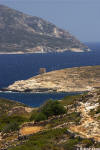



Geological History
Complicated and long-lasting geological activity has moulded the Aegean seas and islands into the form they have today, but ten million years ago, an unimaginable period of time for us but almost negligible in geological terms, the area of the Aegean was one continuous land-mass, known as the Aegeis.
In the course of geological time, sections of the Aegeis underwent a process of continuous subsidence and elevation. During the Pliocene (between 5 million and 1.6 million years ago) the area was finally submerged by the sea. At the same time, the sinking of the African plate under the Eurasian caused the eruption of volcanos and the creation of islands along what is today called the volcanic arc of the Aegean.
Among those islands was also Kimolos, which was probably joined to Milos, Polyaigos and Antimilos. Volcanic activity lasted for roughly 2 million years and finally ceased around 100.000 years ago. During that time, as the sea level rose and fell, the shape of the four islands changed from time to time, sometimes being joined and sometimes separated.
Even though the precise sequence of geological events is uncertain, it appears that none of the four islands was ever linked with the mainland. That is evident from the occurrence of numerous endemic species of plants and animals, that is to say species found exclusively in the island complex of Kimolos-Polyaigos-Milos-Antimilos. The existence of two endemic vertebrates proves that the isolation of these islands is indeed lost in a distant geological time.


Rocks and minerals
The subsoil of Kimolos is almost exclusively made up of volcanic rocks of considerable economic interest as they have supported the economy of the island from antiquity. The most important minerals of Kimolos and the neighbouring islands are bentonite, kaolin and perlite.
Bentonite: This is widely used in industry (oil drilling, foundries, ironworks, insulation), as well as in agriculture and pharmaceutical production.The greatest concentration of bentonite is found in the region of Prassa, where the only active mine of the island is situated. Older quarries can still be seen on the south coast of the island (in Stentas, Ennias, Fikiada, Dekas) and in Polyaigos.
Kaolin: Known in ancient times as "Kimolian earth", it was used as soap for washing clothes. Today, it is used mainly in the paper industry, in ceramics, in rubber and the cement industry.It is found on the south coast of the island, but it is extracted only in the area of Kalamitsi.
Perlite: Its texture is characterized by the presence of small granules, resembling pearls. It makes excellent material for heat, sound and fire insulation and is used as inert matter in building materials. It is used as a filter in the food industry and in the production of drinkable water. Also, it constitutes an excellent soil conditioner. Deposits of perlite have been confirmed in the locality of Xaplovouni.
Building material (poros stone): There was intense activity in block manufacture from white volcanic rock, called tuff, until 1960. The stone was not only used as a building material in Kimolos, but also in Athens and Piraeus. Remnants of its extraction are found in the piles of broken stones in the region of Klima, Kara and Agios Minas.


Hot springs
There are hot springs in at least two areas (Prassa and Agioklima), but they have not been developed yet. The high temperature of the water (46 –50C) was the first clue to the existence of underground geothermal reservoirs, later confirmed by drilling. The heat stored in these reservoirs is an exploitable form of energy, . Today, the geothermal energy is used for water desalination plants. However, it is likely that there are deeper and hotter reservoirs, which could be used directly for the production of electricity.
